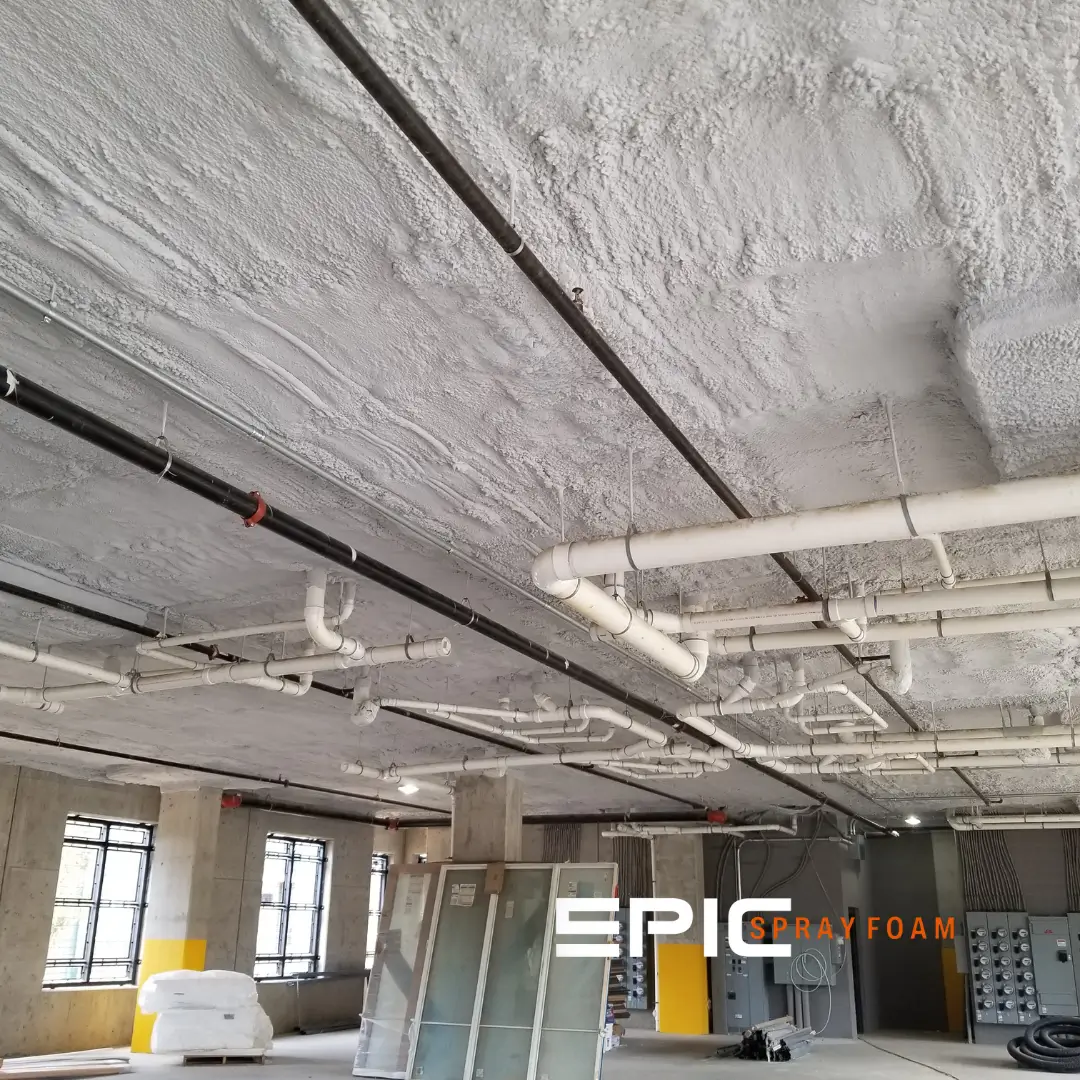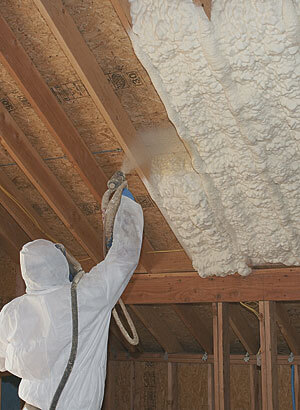Recognizing the Benefits of Using Spray Foam for Insulation Projects
Recognizing the Benefits of Using Spray Foam for Insulation Projects
Blog Article
Spray Foam: The Ultimate Option for Air Sealing and Insulation
Spray foam insulation has emerged as a leading service for efficient air securing and thermal insulation, providing a distinct combination of buildings that set it apart from traditional approaches. Recognizing the full extent of its advantages, setup processes, and contrasts with other insulation types is critical for making informed decisions.
What Is Spray Foam?
Spray foam is a flexible insulation material that integrates the concepts of air securing and thermal resistance to enhance energy performance in buildings. Composed primarily of polyurethane or various other comparable compounds, spray foam is applied as a fluid that increases upon call with surfaces, producing a strong, constant layer of insulation. This special property permits it to fill up spaces, fractures, and spaces that traditional insulation materials may neglect, giving a premium air seal.
There are 2 primary kinds of spray foam: open-cell and closed-cell. Open-cell spray foam is lighter and much more versatile, offering excellent audio absorption and a reduced R-value per inch - Spray Foam. On the other hand, closed-cell spray foam is denser, providing a higher R-value, dampness resistance, and added structural honesty to developing elements
The application process typically involves specific equipment, ensuring a smooth application that complies with numerous substratums, consisting of wood, concrete, and steel. This versatility makes spray foam appropriate for both brand-new buildings and retrofitting existing frameworks. Its ability to develop an impermeable obstacle dramatically adds to lowering power usage and improving interior air quality, therefore making it a preferred choice among home owners and builders alike.
Benefits of Spray Foam Insulation
Among the most substantial benefits of spray foam insulation is its outstanding capability to develop a continual air barrier, which effectively minimizes power loss. Unlike typical insulation products, spray foam broadens to load spaces and splits, guaranteeing that air leakage is significantly reduced. This characteristic not just boosts power effectiveness yet likewise brings about reduce utility costs in time.
Additionally, spray foam insulation gives exceptional thermal resistance, adding to a much more steady indoor setting. Its high R-value per inch allows for effective insulation in confined rooms, making it suitable for attic rooms, walls, and crawl spaces. Furthermore, the moisture-resistant residential properties of spray foam help avoid mold and mold development, promoting much healthier living conditions.
An additional important benefit of spray foam insulation is its sound-dampening top qualities (Spray Foam). It efficiently decreases sound transmission between rooms, developing a quieter and a lot more comfortable home atmosphere. The sturdiness of spray foam additionally sticks out, as it does not droop or work out over time, maintaining its efficiency throughout its life-span
How Spray Foam Works
Understanding exactly how spray foam insulation works is important for valuing its effectiveness in air sealing and thermal resistance. Spray foam insulation contains two key components: isocyanate and polyol resin. When these elements are combined, they go through a chemical reaction that creates the material to expand rapidly, developing a dense foam that fills voids, cracks, and cavities.
As the foam broadens, it complies with surfaces, forming an airtight seal that significantly reduces air infiltration. This particular makes spray foam insulation very effective at stopping drafts and moisture penetration, which can cause energy loss and damage gradually. In addition, the closed-cell version of spray foam uses exceptional thermal resistance due to its stiff framework, successfully decreasing warm transfer.
The special homes of spray foam allow it to satisfy uneven surface areas, guaranteeing thorough coverage and a smooth barrier. As an outcome, spray foam insulation not just improves energy performance yet additionally adds to enhanced indoor air high quality by lowering the accumulation of irritants and contaminants. Inevitably, recognizing the technicians behind spray foam underscores its function as a superior option for insulation and air sealing in both business and property applications.
Setup Process Summary

Prior to setup, the space should be sufficiently cleaned up and prepped, making certain that surface areas are complimentary from dampness, dust, and particles. Due to the fact that impurities can endanger attachment and overall performance, this step is reference important. When the area is prepared, the application involves mixing the two components of the spray foam, which broadens upon get in touch with and fills up gaps efficiently.
Trained professionals should perform the installment, using specific equipment to ensure uniform insurance coverage and optimal density. Safety precautions, including putting on safety gear and ensuring correct air flow, are essential throughout this procedure. After application, the foam normally remedies quickly, creating a solid barrier that boosts energy performance.
Contrasting Spray Foam to Conventional Insulation
When examining insulation choices, spray foam insulation stands out in comparison to traditional materials such as fiberglass and cellulose. Unlike fiberglass and cellulose, which can allow air seepage, spray foam increases upon application, loading voids and crevices to create an airtight seal.
Additionally, spray foam provides a higher R-value per inch than typical insulation types, providing even more effective thermal resistance in a thinner profile. This particular is especially valuable in spaces with limited cavity deepness. Additionally, spray foam is resistant to dampness and mold growth, which can be a substantial interest in cellulose and fiberglass, particularly in damp environments.
Nonetheless, spray foam insulation generally lugs a higher ahead of time expense than its traditional counterparts. House owners should evaluate this first financial investment versus long-lasting energy savings and performance benefits. Eventually, while both insulation kinds serve their function, spray foam becomes a much more advanced remedy for modern-day insulation requirements, specifically in regards to air sealing and thermal effectiveness.

Verdict
In recap, spray foam insulation stands for a very efficient solution for accomplishing optimum air sealing and try here thermal resistance. Its one-of-a-kind residential or commercial properties, including moisture resistance and sound dampening, make it appropriate for different applications in both new building and constructions and retrofitting jobs (Spray Foam). The initial costs may be greater contrasted to standard insulation materials, the lasting advantages, such as considerable power savings and improved indoor air high quality, validate the financial investment and highlight its worth in contemporary structure techniques.
Spray foam insulation has emerged as a leading service for efficient air securing and thermal insulation, supplying an unique mix of properties that establish it apart from standard techniques.Spray foam is a versatile insulation material that combines the concepts of air securing and thermal resistance to improve power performance in structures.When assessing insulation choices, spray foam insulation stands out in comparison to traditional products such as fiberglass and cellulose. Ultimately, while both insulation types serve their imp source objective, spray foam emerges as a much more innovative service for contemporary insulation demands, particularly in terms of air sealing and thermal effectiveness.
In recap, spray foam insulation represents a highly efficient remedy for accomplishing optimal air sealing and thermal resistance.
Report this page